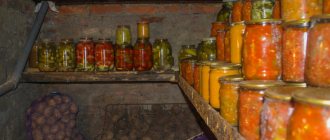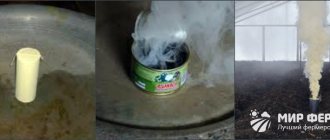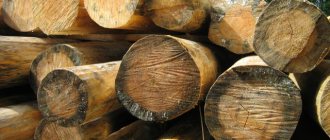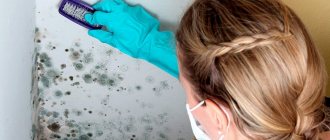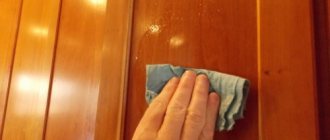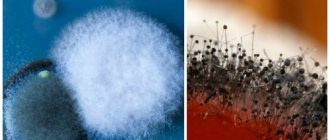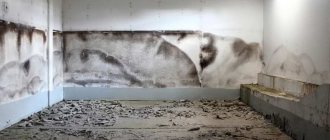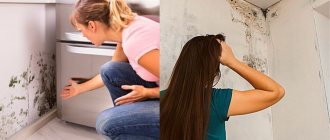If upon entering the basement you begin to notice an unpleasant smell of mold, then you cannot turn a blind eye to the problem. Even if only old things are stored in the basement of a concrete house, mold and mildew spread quickly. After some time, the spores will penetrate into living quarters.
And if the basement is also used as a cellar for storing pickles and food, then measures to get rid of mold and mildew must be taken not only immediately, but also very carefully. Otherwise, you risk your health.
Why are fungus and mold dangerous?
For a long time, it was believed that the most dangerous thing was to eat food with mold. However, later it was possible to prove that in the acidic environment of the stomach, spores are not able to grow and simply die. The most dangerous thing is that a person who inhales such particles can get a lung infection called aspergillosis. It is very difficult to cure such a disease.
Some types of spores can cause asthma, cough and other respiratory diseases, frequent headaches, rashes and much more. The most difficult thing about all this is that mold and mildew can penetrate into the smallest cracks and spread with great speed. Therefore, it is advisable not to allow the basement to be a favorable environment for such microorganisms.
Harm to human health
The fungus tends to spread quickly, and the fact that indoor surfaces are contaminated is a minor problem when compared with the threat to human health. Mold spores can enter the human body through the respiratory tract and settle in the lungs, and can also be ingested through skin, hygiene items and food. For this reason, mold control is an important hygiene measure. Some types of fungus cause asthma, headaches, dry cough and skin rashes.
During its life in the basement, the fungus actively releases harmful toxins in the form of numerous spores that are dangerous to humans.
Doctors associate prolonged contact with such substances with the occurrence of such diseases:
- Migraine;
- Chronic respiratory diseases;
- Increased irritability;
- Allergies.
Mold is believed to be dangerous for young children because their respiratory systems are not fully developed. Children exposed to fungi may be at risk of developing chronic respiratory diseases and allergies. The danger of mold spores is explained by their invisibility to the human eye. In the first stages, mold development does not look scary. However, discoloration of the walls in the cellar, black formations on the ceiling and peeling of the walls require emergency intervention.
What causes mold and mildew to appear?
You should not believe that concrete is resistant to such things. Mold can pass through microcracks and spread to the surface of the concrete without particularly affecting it. There are several factors that provoke the development of mold:
- Lack of ventilation. Coupled with humid and warm air, this becomes an almost ideal environment for such particles.
- Insufficient access to daylight. Ultraviolet light prevents mold from growing.
- Formation of condensation. Often the waterproofing of the basement is not performed to the required level. Perhaps there is no blind area and groundwater is not drained effectively enough.
- Long-term storage of products that have already begun to deteriorate and rot.
- The presence of wooden shelves and racks (for this type of room it is better to use metal or plastic).
If fungus and mold have already appeared, then the method of getting rid of them depends on the affected area. When particles have just appeared, you can get by with simpler means.
☝️ Prevention rules
Prevention is always easier than fighting. It is necessary to carry out general preventive measures, even if your cellar is dry:
- Throw away spoiled food promptly.
- Coat wooden elements with protective agents.
- Monitor the ventilation system.
- Periodically force dry the room using an electric dryer.
- Fumigate the cellar with a sulfur bomb once a season.
- Treat surfaces with a disinfectant from time to time.
If there is a small amount of mold or mildew
In this case, the easiest way is to use folk remedies that are least likely to harm a person. But sometimes you have to use more powerful compounds.
Fire treatment
In this case, you can use a blowtorch or other available means. This is a mechanical method of mold removal that will help solve the problem only at the initial stage. After burning off the mold, it is imperative to solve the problems that caused the appearance of dangerous particles.
Vinegar
In 80% of cases, this remedy helps get rid of mold if the affected area is small. If small dots appear on the walls or ceiling, you can “cauterize” them with ordinary table vinegar applied to a clean sponge. You can also dilute it in water in equal parts and rinse the affected surfaces thoroughly.
If the basement is seriously infested, you can prepare a more powerful remedy. For this:
- Pour half a glass of water into a container.
- Add 50 ml of table vinegar and the same amount of hydrogen peroxide.
- Add 25 ml of boric acid.
- Slowly mix all the ingredients and heat the resulting mixture over low heat to 50-70 degrees.
- Immediately, while the mixture is warm, apply it to the affected areas of the concrete walls and ceiling.
- We wait 15 minutes.
- Clean the surface with an old brush. We throw it away.
Although this is a relatively complex recipe, it pays off.
Hydrogen peroxide
In this case, we will need regular 3 percent hydrogen peroxide, which is sold at any pharmacy. Since it is already very diluted, there is no need to dissolve the liquid in water. It is enough to apply peroxide to a soft sponge and walk it over the walls and ceiling.
Due to the fact that the composition contains only 3% hydrogen peroxide, this product may not provide long-term results. For a more advanced situation, you can make a concentrated composition:
- We buy tablets called “Hydroperit” at the pharmacy.
- We dilute (one piece is enough) in water according to the instructions.
- We obtain a concentrated mixture that is applied to mold-affected areas.
Lemon acid
This is a very effective method of killing mold. But if the lesions are large, then you will have to spend a lot of money since citric acid is expensive. In this regard, it is more often used at the initial stage of fungal development.
Healthy! This method is considered one of the safest for humans.
To prepare the solution, just dissolve 100 g of citric acid in a liter of water. After this, you need to apply the liquid to the areas of infection. The remaining mixture can be distributed in the corners (where mold most often begins to grow). This method will allow you to get rid of not only the external signs of fungi, but also the unpleasant odor.
Reasons why fungus takes a fancy to the basement
If you simply remove mold from the walls of the cellar and treat them with an antiseptic, after some time it will return again. In order to get rid of fungus with a guarantee, it is necessary to determine the original reasons why it affected the basement in order to eliminate them.
- poor waterproofing. The proximity of groundwater formed from precipitation: for example, melting snow, heavy rains - increases the humidity in the cellar itself, which contributes to the spread of mold;
- errors in construction. For example, the presence of cracks in the walls or ceiling through which water flows into the basement;
- poorly thought out ventilation system, there is practically no air circulation;
- the darkness in the cellar, the absence of sunlight does not allow the condensation that settles on the walls to evaporate;
- the presence of a rich breeding ground for mold spores (from wooden structures to stored vegetables and other products);
- storage of rotten, moldy vegetables and fruits.
What are the first signs that mold is starting to spread in your cellar?
- smell of mustiness, rot;
- condensation on walls and shelves;
- stale air.
Thus, first of all, you will have to block all possible ways of water entering the cellar, ensure air circulation (ventilation) and get rid of products already affected by mold.
If the lesion is quite large
Mold grows quickly, and sometimes we don’t go into the basement for a long time. If the infection has spread along the walls and ceiling, then you should use the following means.
Chlorine
This is heavier artillery that will help get rid of large areas of infection. But, you need to take into account that chlorine fumes are also dangerous for humans, so you need to work with a mask, gloves and be sure to ensure good ventilation in the room.
Any chlorine-containing product is suitable for processing. For example, the cheapest option is “Whiteness”. Some people use a concentrate of this product, while others dilute it with water in a 1:2 ratio.
Cleaning is done as follows:
- We clean the affected area from mold and other infestations using a wire brush or coarse sandpaper.
- Apply a chlorine-containing compound to a dishwashing sponge and thoroughly wipe the walls with it.
- We repeat the treatment several times so that the composition can penetrate deeper.
Healthy! When using chlorine, it is not recommended to use a spray bottle.
After this, you need to ventilate the room for several days. The smell of chlorine is very pungent, so you should wait until it completely evaporates. As a rule, if mold appears after this, it will be after a longer period of time.
Boric acid
This product is most effective against white mold. To prepare a cleaning solution, you need to mix 1 kg of salt and a bag of boric acid (100 g) in 0.5 buckets of water. All components should dissolve well. After this, the composition is poured into a sprayer and the surfaces are treated.
Copper sulfate and lime
In this case, you will need 100 g of vitriol and 1 kg of quicklime, which are mixed into the whitewash solution. To do this, vitriol is first added to a bucket of water and mixed. After this, add lime. At the next stage, it is enough to distribute the product over the walls and ceiling.
If there is black mold in the concrete basement, then more vitriol can be added (300 g). For pinpoint lesions, you need to dilute it in 3 liters of water. This vitriol concentrate will quickly get rid of the infection.
It is not necessary to add lime. But, it gives the mixture the necessary adhesion. Therefore, the finished composition will stay on the walls longer. It is recommended to carry out treatment once a year, before the onset of the warm season.
Hydrochloric acid
This method cannot be called safe, but if the mold continues to actively grow, then there is nowhere to go.
Healthy! You can only work in a respirator, goggles and protective clothing.
For processing, a solution is used, not a concentrate. The product can be diluted in different ratios, so before using hydrochloric acid you must read the instructions for the purchased composition. The product is applied to all surfaces (except zinc), and not just to areas of mold and mildew.
Specialized means
Such compositions perform two functions at once: they effectively get rid of mold and mildew, and also prevent their further development. As a rule, products are produced in the form of deep penetration primers.
The most popular are:
- ArmMix Biocide Gel. Suitable for processing concrete and stone. Usually sold in 1 liter canisters as a concentrate, which is diluted in a ratio of 1:5. Thus, one container is enough for a large area. Consumption is approximately 150-300 ml per “square”. The product costs about 330 rubles per canister. The product is odorless and does not contain chlorine or other hazardous components.
- Olimp Stop mold. This is an antiseptic that destroys mold and mildew, but is completely safe for humans and pets. It contains no toxins, chlorine or anything else. Can be used on both wood and concrete surfaces. Only in the second case is it not the impregnation that plays the role, but the removal agent. Liquid consumption is 200-250 ml per m2. The product is usually sold in five-liter canisters for 480 rubles. But you can also find a smaller volume.
- Neomid Bio. This is another safe concentrate that is sold in convenient 0.5 liter bottles equipped with a dispenser. Costs about 470 rubles. It must be diluted strictly according to the instructions. Otherwise there will be no effective result.
Precautions when processing the premises
When processing the cellar you need to be extremely careful and attentive. Many of the ways to combat mold involve the use of chemicals. In addition, the danger lies in the mold itself, so do not allow it to come into contact with your skin.
When treating a room with chemicals, use a protective mask and suit.
Before processing the cellar, put on protective clothing, use a respirator or even a gas mask. Hands should be protected with rubber gloves.
Following the mold control measures described above will allow you to get rid of the fungus, and annual preventive measures will prevent the problem from recurring. Remember! It is better to prevent a “disease” than to treat it!
Conditions for reproduction are flexible
Why does one owner have fungus in the basement, but not another? In order for such “life” to appear, several conditions must be met. This:
- Spores in the air that can land on people, animals, and various products.
- Availability of a nutritious organic environment.
- Mold develops if the humidity level in the room is high and the air temperature is 20 degrees or higher.
Various types of mold can lose their ability to reproduce and develop at low air temperatures - from 0° and below. Separately, it is necessary to say about ventilation. Ventilation systems are designed to ensure normal air circulation. When there are movements of air currents, this prevents the spores from attaching to the surface.
In the corners of rooms, air flows often move weakly - it is in the corners that these colonies accumulate.
The ventilation system also removes excess moisture from the air, which is formed due to high humidity outside the cellar or due to a large temperature difference between the outside of the house and the inside of the basement. If there are traces of a fungal colony on the wall, but there are no conditions for reproduction, then germination will not occur. It turns out that the cause of everything is poor ventilation.
On video: the reasons for the appearance of fungus on the walls.
How to remove moisture in the cellar
To ensure fresh air enters the room, it is necessary to improve ventilation. If the basement is located in a private house, this can be done by installing vents or vents in the basement part of the foundation, closed with bars with small cells so that rodents cannot penetrate through them. However, this method is effective only if the basement area is small and the ceiling is no higher than two meters.
In rooms with a larger area, more complex ventilation systems are installed, called supply and exhaust. It looks like this.
However, in some cases, such “natural” systems lose their effectiveness. In such cases, forced ventilation systems, or, more simply, fans, are installed in the cellars.
It is important to remember safety precautions - protect electrical appliances from water. This can be done by installing a fan in the exhaust pipe of the room so that the air is blown out.
